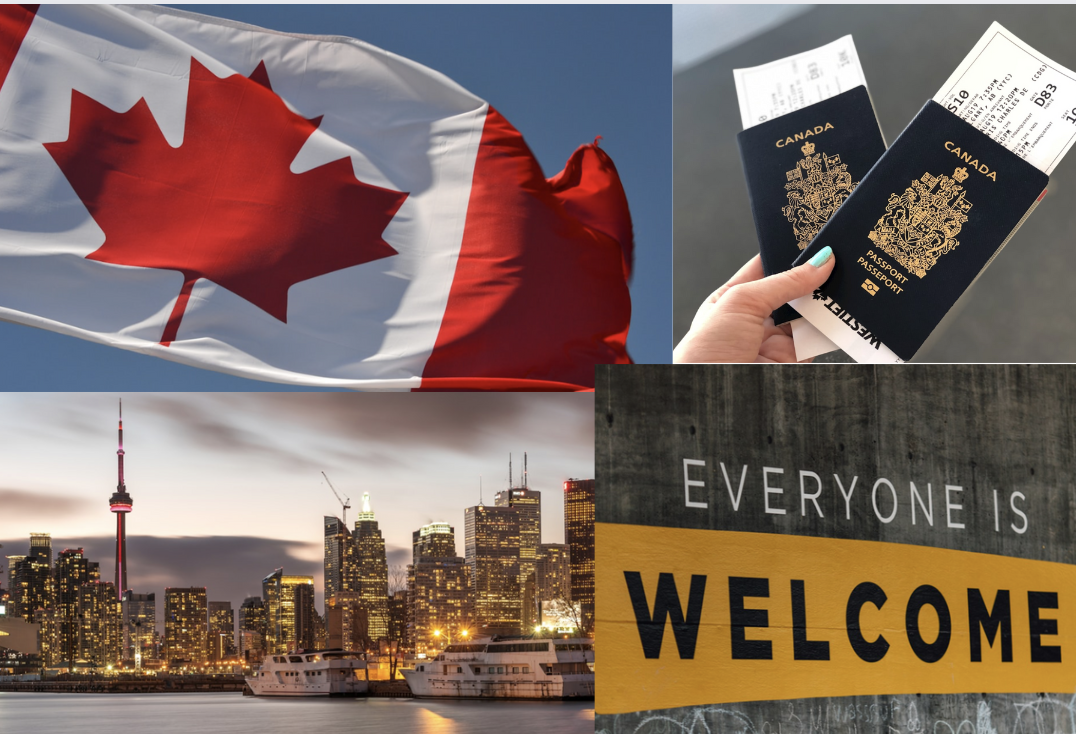How to get Canadian Immigration in 2024
Canada is giving away work permits and permanent residency to international migrants. This guide will give you a clear idea of how to get Canadian immigration without wasting any of your time.

Despite having a twenty-five percent immigrant population, Canada is looking to welcome 1.4 million immigrants by the end of 2026. And now is high time to pin your name to that list.
Although there are 80 pathways to immigrate to Canada, the immigration process, in particular, is not easy. So, to save your time, hopes, and dreams, we’ve gone through those 80 ways and found 9 legit methods to move to Canada, hassle-free.
1. Family Class Sponsorship
Families in Canada can sponsor their family members to come to Canada and get permanent residence. To be eligible for sponsoring a relative to Canada, one must be a Canadian citizen or permanent resident, and at least 18 years of age. Also, one can only sponsor one’s husband/wife and children (who are under the age of 22). However, there are some exceptions. i.e. one can sponsor one’s relatives but under very specific conditions).
Here is how to get Canadian immigration using family class sponsorship:
- Download the Family Class Sponsorship Application Package from the Government of Canada website.
- Fill out the PDF forms digitally and include the details of the sponsor and the relatives being sponsored.
- Gather necessary documents in the application package, and fill out their checklist.
- Submit the sponsor application online through the Permanent Residence Online Application Portal.
- Sponsored people must fill out digital forms online, apply for permanent residence, and pay for the application fees.
- The application fee for a child is $150, while that for an adult (22 years or older) is $1080.
- Make sure to provide medical exams, police certificates, and biometrics as requested during the application process.
Note: Once you are confirmed eligible, you will receive a request to link the application to an online account. This process may take a while. So, do regularly check for updates on your application status and respond on time.
More information about the application process can be found here.
2. Study Permit
Canada offers permanent residency to foreign students. For this, you need to have an admission letter from an authorized institution based in Canada, proof of sufficient funds to cover your tuition and living expenditures as well as a clean slate on the criminal record. Once you have all that in check, you are ready for permanent residency in Canada.
Here's how easy is it to get Canadian immigration through a study permit:
- Get an acceptance letter from a Designated Learning Institution (DLI).
- Make sure you have a valid passport or a travel document.
- Get a Provincial Attestation Letter (PAL) from the province or territory where you intend to study (usually necessary for most students).
- Provide evidence of financial support.
Note: All secondary and elementary schools in Canada are authorized ‘Designated Learning Institutes’. Also, the duration of your study permit will be the same as your degree program. While on your study permit, you can apply for permanent residence in Canada.
You can find more information about this process here.
3. Express Entry Program
Skilled workers can get Canadian Immigration through Express Entry.
Express Entry manages 3 types of immigration programs:
- Canadian Experience Class: for skilled workers with at least 3 years of work experience in Canada.
- Federal Skilled Worker Program: for skilled workers with foreign work experience. Although they have to meet the criteria for education and other factors.
- Federal Skilled Trades Program: for skilled workers who are qualified in a skilled trade. They must have a valid job offer or a certificate of qualification.
See details for eligibility criteria here.
You can apply through this process in 5 steps:
Step 1: Find out if you are eligible.
Step 2: In the Express Entry pool, you are ranked using a point-based system known as CRS (Comprehensive Ranking System). You can use the CRS tool to estimate your score.
Step 3: Prepare your documents. E.g., language test results, educational credential assessment report plus provincial nomination, and a written job offer from an employer in Canada (if you have one).
Step 4: Create an account on the IRCC website, fill out the application for applying through Express Entry, and SUBMIT it along with all the required documents and the application fees. Application fees for an adult to apply through Express Entry is $1365. You can include a spouse for an extra $1365 and a child for $230.
Step 5: Candidates with the highest scores (CRS) will be sent an invitation to apply for permanent residency. Your completed application along with all the supporting documents will be processed in 6 months or less.
More details about this process can be found here.
4. Provincial Nominee Programs
Canada is aiming to welcome 117,500 new immigrants through Provincial Nominee Programs by the end of 2025. Most Provincial Nominee Programs require applicants to have a connection with the province (like a sponsor) while others rely on the labor market needs. All PNPs take different pre-processing times.
It could take 6 months to get a Canadian immigration visa through Provincial Nominee Programs. Once you are nominated, you will need to apply to the federal government for Canadian permanent residency.
Here's how to get Canadian immigration with Provincial Nominee Programs:
- Check your eligibility for the PNP.
- Apply to the specific PNP stream.
- If nominated by the province or territory, apply for permanent residence online.
- Go through a medical exam and get a police check.
- Upon approval by IRCC, you can finalize your permanent residence landing in Canada.
If you are eligible for one of the Express Entry Programs, you can apply for Provincial Nominee Programs through an Express Entry process as well.
Note: The cost of moving into Canada via PNP is the same as that of the Express Entry System. The cost varies based on the Canadian province. If you apply for Ontario, the charges would be around CAD 1,500 (USD 1,100).
(CAD = Canadian Dollars, USD = United States Dollar)
Find more information about this process here.
5. As a Self-Employed Person
If you have relevant experience in cultural activities or athletics, you can immigrate to Canada as a self-employed person. To qualify in this category, you should be a professional athlete and should have represented your country or region at a world-class level.
A self-employed person must establish a business that will, at a minimum, create an employment opportunity for themselves and that will make a significant contribution to cultural activities or athletics in Canada.
- See more details of eligibility criteria here.
- You will need certain documents to apply for this program.
- If you fully meet the eligibility criteria, you can apply through a permanent residence online portal account.
- See instructions for filling out the application form here.
The fee for applying for this program is $2140.
More information about this program can be found here.
6. Business Immigration
If you have run a business before and want to do it in Canada, you can do so via a federal or provincial business immigration program.
Canada's federal government has immigration programs for people planning to be self-employed or start a business in Canada. And some provinces (like Ontario) have programs for foreigners who want to start a business there.
These programs usually need you to invest a lot of money in the business you want to start in Canada. The amount varies depending on the program. Some provinces have special programs with lower investment requirements if you want to start a business in a less crowded area.
Here's how to get Canadian immigration through a Business immigration program:
- See if you qualify for a Canadian business immigration program.
- Choose the right program based on your business goals and investment capacity.
- Start or buy a business in Canada, investing at least CA$100,000 to CA$350,000, depending on the type of business.
- Apply for a work permit based on your business ownership or investment.
- Operate your business in Canada for a specific period, meeting certain requirements.
- Once your business is established and operational, apply for permanent residency in Canada.
- Fill out additional criteria for permanent residency, such as language skills and education.
- After living in Canada as a permanent resident for at least 3 years, you can apply for Canadian citizenship.
See more information about this program here.
7. LMIA Work Visa
Many people who want to move to Canada first need to find a job there. Then, the employer applies for a Labor Market Impact Assessment (LMIA), which is basically a permission slip for the job. Once it's approved, the person can apply for a work permit. If everything goes smoothly, this can lead to getting permanent residency in Canada. Here's how to get Canadian immigration through LMIA Work Visa:
- Look for a job in Canada, and get an LMIA from Employment and Social Development Canada (If you're a Canadian employer, apply for an LMIA through Service Canada).
- After the employer receives a positive LMIA, you are good to apply for a foreign worker job.
- Apply for a work permit from Immigration, Refugees and Citizenship Canada (IRCC).
Once you get a Labor Market Impact Assessment (LMIA), you can apply for a worker permit. For these, you need the following documents:
- A job offer letter from the corporation
- A written contract from the corporation
- A copy of the LMIA
- The LMIA number
Find more information about this program here.
8. Canadian Investor Immigration
The Canadian Investor Immigration is for wealthy foreigners who have business experience and comes in two main programs: The Federal Investor Program and the Quebec program.
Both programs require a high net worth and substantial investment in an approved fund for five years. Here is how to get Canadian immigration through Canadian investor immigration programs:
- Look for federal and provincial investor immigration options.
- Review investment amounts, net worth, and business experience required for the chosen program.
- Develop a solid business plan aligned with program requirements.
- Complete and submit your application with all necessary documents.
Note: Once you applied successfully, you will have to wait for IRCC to review your application and process it. Once approved, you will receive a work permit to operate your business in Canada.
Find more information about this program here.
9. Temporary Foreign Worker Program
If you're wondering how to get a job with Canadian Immigration, then the Temporary Foreign Worker Program is the one for you. The Temporary Foreign Worker Program (TFWP) is a great option for Canadian employers who are looking to hire foreign nationals temporarily to fill labor shortages.
This requires a Labor Market Impact Assessment to express the need for foreign workers including agriculturalists, in-home caregivers, and foreign teachers. The Global Talent Stream expedites hiring highly skilled global talent. Quebec has its unique procedures, including language requirements and LMIA exemptions for certain workers.
- Check if the position or worker qualifies for an LMIA exemption.
- If yes, then apply for a Labor Market Impact Assessment from Employment and Social Development Canada, and pay a compliance fee (i.e. CA$230).
- Use the International Mobility Program's Employer Portal to submit the official job offer.
- Once done, you can apply for their work permit.
Note: Qualified workers may apply for expedited processing through the Global Skills Strategy for certain NOC Skill Level A or 0 positions.
FAQs
Q.1. How can I get immigration in Canada?
If you want to immigrate to Canada, you will have to take a language proficiency test and get your academic documents attested. Once you complete these requirements, you can go ahead and apply for a specific program (i.e. Express Entry or the Provincial Nominee Program). Once done, wait for the response. This may take a while. Also, you need to make sure your travel agent tells you the details and heads-up on immigrating to Canada.
Q.2. Why is Canada open to immigration?
Canada has a shortage of skilled labor which has slowed down its economic growth. With the help of immigration programs, the country caters to this crisis and maintains economic competitiveness.
Q.3. What level of government is responsible for immigration in Canada?
The federal government is responsible for immigration in Canada. This government body collaborates with provinces and territories to implement immigration policies. This partnership reflects shared jurisdiction in immigration matters between the federal and provincial/territorial governments.
Q.4. What are the benefits of immigration?
Immigration brings several benefits to the country. For Canada, it means stimulating economic growth, encouraging innovation, and enhancing the productivity of native-born workers.
Conclusion
Canada is looking to get 1.4 million international applicants and offer them permanent residency by 2026. To meet this high-end demand, the federal government is offering a handful of options for a variety of foreigners. If you're looking for a way how to get Canadian immigration, make sure to check your eligibility criteria for any of the 9 options mentioned above. However, there are some other options to immigrate to Canada as well, which you can find here.





